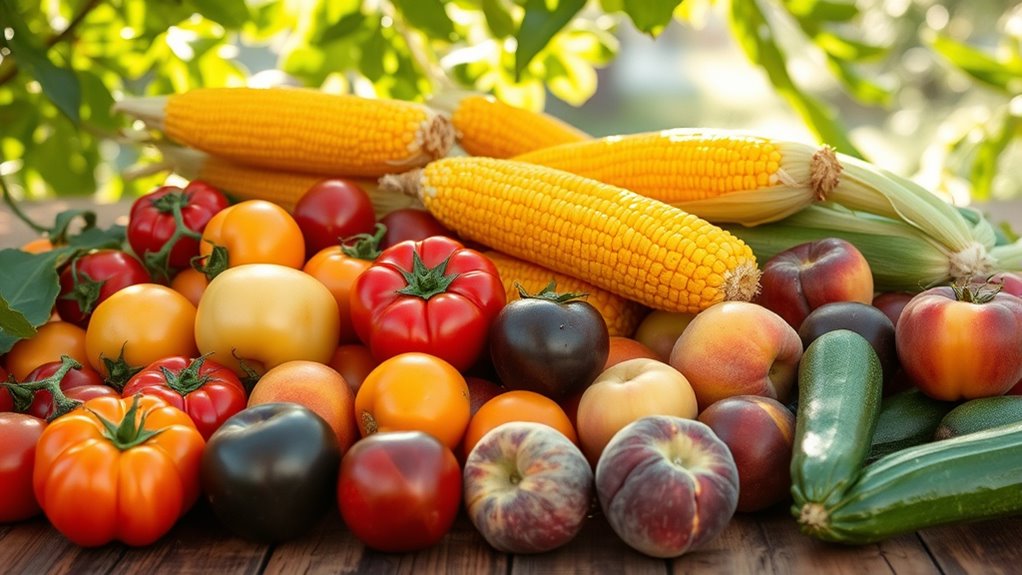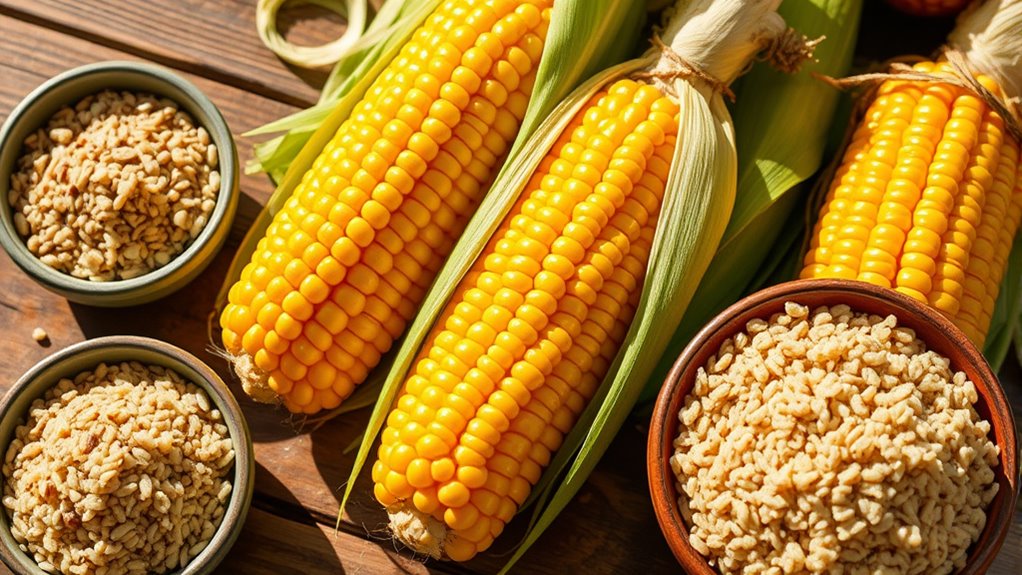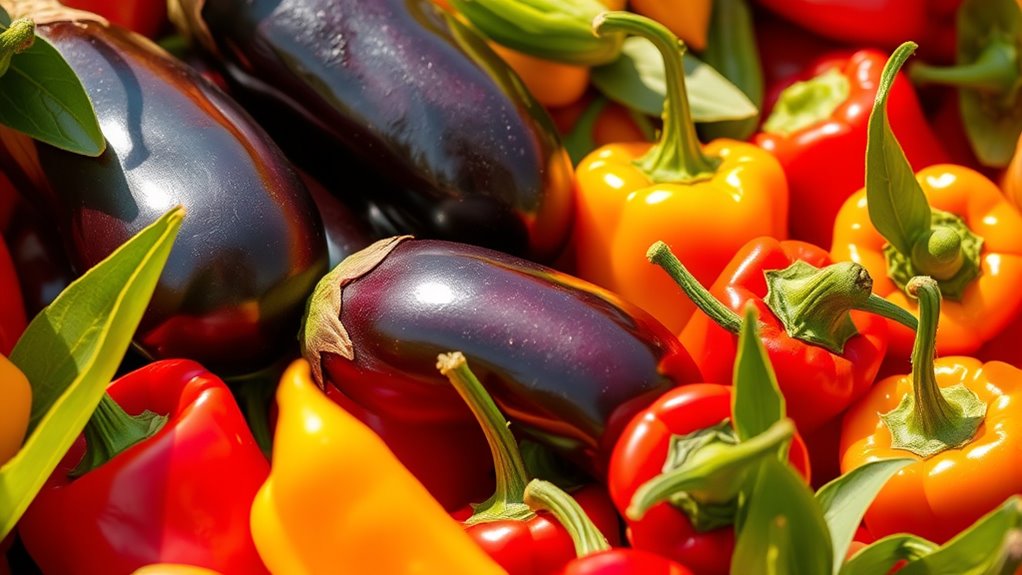Eating seasonal in summer lets you enjoy fresh, flavorful produce that’s packed with nutrients and supports eco-friendly farming. Fruits like berries and melons hydrate and satisfy, while tomatoes and peppers boost antioxidants and flavor your dishes. Grains like corn add sweetness, and cucumbers and zucchini keep things light and invigorating. To get the most from these superfoods, learn how to select and store them properly—more tips await as you explore further.
Key Takeaways
- Summer produce like tomatoes, berries, melons, peppers, and eggplants are nutrient-dense and versatile for various dishes.
- Eating seasonal summer foods supports sustainable farming, reduces carbon footprint, and lowers grocery costs.
- Peak-season grains such as corn and rice enhance flavor and texture in fresh, quick meals.
- Proper selection and storage of summer produce preserve freshness, flavor, and nutritional value.
- Incorporating summer powerhouses boosts immune health with antioxidants and essential vitamins naturally abundant in these foods.
The Benefits of Eating Seasonally in Summer

Eating seasonally in summer offers numerous benefits that can enhance both your health and your lifestyle. When you choose to eat summer produce, you support sustainable farming practices that prioritize local and eco-friendly methods. Seasonal eating benefits include higher nutrient levels, as fruits and vegetables are harvested at their peak ripeness, maximizing flavor and health benefits. Additionally, eating seasonally often means lower costs, since local produce is more abundant and doesn’t require long transportation. By aligning your diet with the seasons, you reduce your carbon footprint and promote environmentally responsible choices. seasonal produce is often more flavorful and nutrient-dense because it is harvested at its peak ripeness, which enhances the overall quality of your meals. Summer’s bounty encourages variety and freshness on your plate, helping you enjoy delicious, nutrient-rich foods while supporting sustainable agriculture and embracing a healthier, more mindful way of eating. Incorporating local food sources into your meals can also inspire creativity in the kitchen, making healthy eating an enjoyable experience. Consuming seasonal foods can also boost your immune system by providing essential vitamins and antioxidants naturally available during these months. Moreover, choosing seasonal produce can also help you access nutrient-rich foods that are more abundant during summer, ensuring you get the most health benefits from your diet.
Tomatoes: The Summer Staple for Flavor and Nutrition

Tomatoes are a summer favorite that pack a powerful punch of antioxidants, helping you stay healthy while enjoying their bright flavor. You can use them in countless dishes, from salads to sauces, making them incredibly versatile. Incorporating fresh tomatoes into your meals maximizes both flavor and nutrition during the season. Exploring automated technology in your kitchen can further enhance your cooking experience, providing innovative tools to prepare delicious summer meals more efficiently. For those looking to enhance their culinary experience, experimenting with seasonal produce can bring even more freshness and flavor to your summer meals.
Rich in Antioxidants
During the summer months, tomatoes become a powerhouse of antioxidants that boost your health and enhance flavor. These antioxidant-rich foods help protect your cells from damage caused by free radicals, reducing the risk of chronic diseases. As a seasonal superfood, ripe tomatoes are packed with lycopene, a potent antioxidant linked to improved heart health and cancer prevention. Eating tomatoes in their peak season guarantees you get the maximum nutritional benefits. Incorporate them into salads, salsas, or simply enjoy them fresh to take advantage of their health-boosting properties. By choosing seasonal superfoods like tomatoes, you support your wellness while savoring the vibrant flavors of summer. Their rich antioxidant content makes them an essential part of your summer diet. Understanding the benefits of antioxidants can help you make more nutritious choices during the season.
Versatile Culinary Uses
Thanks to their vibrant flavor and adaptability, tomatoes are a summer kitchen essential that can be used in countless ways. You can blend ripe tomatoes into pesto variations, creating fresh sauces full of flavor for pasta or drizzling over grilled veggies. Their juiciness makes them perfect for salad dressings, adding a natural sweetness and tang. Sliced tomatoes work well in sandwiches and burgers, while chopped ones serve as a base for salsas and bruschetta. Roasting transforms them into rich, concentrated spreads or toppings. You can also incorporate tomatoes into gazpachos or cold soups for invigorating summer bites. Their versatility means you can enjoy their flavor raw, cooked, or blended, making them a must-have ingredient to elevate any summer meal. Additionally, appliance integration with smart kitchen devices can help you monitor and optimize the freshness of your tomatoes to enjoy peak flavor longer. The seasonal nature of tomatoes also encourages mindful shopping and reduces waste, ensuring you get the best quality during the summer months. Incorporating proper storage techniques can further extend their shelf life and maintain their nutritional value. Global culinary uses highlight how tomatoes are celebrated across different cuisines worldwide.
Corn and Other Grains: Sweet, Juicy, and Versatile

Corn and other grains shine during their peak season, offering a sweet, juicy, and versatile flavor that enhances countless dishes. With various grain varieties like sweet corn, wheat, and rice, you have plenty of options for summer cooking. You can boil, grill, or roast corn to bring out its natural sweetness or incorporate it into salads, salsas, and side dishes. Mastering different cooking techniques guarantees you maximize flavor and texture. For instance, grilling corn adds smoky depth, while boiling keeps it tender. Similarly, grains like rice can be cooked plain or seasoned for a quick meal or a hearty salad. Embracing these grains during their seasonal peak allows you to enjoy their freshness and versatility in simple, delicious ways.
Berries and Melons: Nature’s Candy at Its Best

Berries and melons stand out as nature’s sweetest treats when they’re in season, offering vibrant flavors and juicy textures that refresh and delight. You can blend berries into smoothies for a burst of natural sweetness or layer them on yogurt for a colorful dessert. Melons, like watermelon and cantaloupe, are perfect for slicing or adding to fruit salads, providing hydration and flavor. Both berries and melons make excellent dessert toppings, elevating cakes, ice creams, or parfaits with their fresh, juicy notes. Their versatility guarantees you can enjoy them as snacks or incorporate them into various summer recipes. By choosing these seasonal fruits, you not only indulge your sweet tooth but also benefit from their high antioxidant content and hydration qualities.
Cucumbers and Zucchini: Refreshing and Light

As the season shifts from sweet, juicy fruits to crisp vegetables, cucumbers and zucchini emerge as perfect choices for light, invigorating meals. These vegetables are ideal for cool summer soups and chilled vegetable salads, keeping you revitalized on hot days. You can slice zucchini thin for a simple salad or spiralize it into noodles. Cucumbers add crunch and hydration, making salads even more invigorating. Both are versatile and easy to prepare, perfect for quick lunches or light dinners. Incorporating herbs, lemon, or vinegar to enhance their natural flavors can further elevate their taste, and utilizing food preparation techniques can further enhance their texture and flavor. Using electric tools like spiralizers or mandolins can make preparation faster and more consistent. Engaging with traditional healing practices such as mindful eating and connection to nature can deepen your appreciation for seasonal produce.
Peppers and Eggplants: Colorful and Nutrient-Dense

Peppers and eggplants come in vibrant colors that brighten any dish and provide a visual feast. They’re packed with antioxidants that help keep you healthy and energized. Plus, their versatility means you can enjoy them in countless recipes, from grilled skewers to hearty stews. Incorporating high antioxidant content in your diet can further enhance your immune system and reduce inflammation.
Vibrant Color Variations
Vibrant colors in peppers and eggplants aren’t just eye-catching; they also indicate a rich array of nutrients. Different hues can influence your fruit pairing choices and reflect unique health benefits. For example, red peppers symbolize energy and vitality, while purple eggplants often represent creativity and wisdom through their color symbolism. Incorporating a variety of these colorful vegetables in your meals not only enhances visual appeal but also maximizes nutrient intake. By selecting peppers and eggplants of different shades, you guarantee a diverse spectrum of vitamins and minerals. Their vivid colors serve as natural indicators of their nutritional profile, encouraging you to enjoy a broad, colorful plate that supports your overall health and well-being. The nutritional benefits of these vegetables are often reflected in their vibrant hues, inspiring a more mindful and nutritious dining experience. Additionally, understanding the impact of color symbolism can motivate a more balanced and enjoyable way to include these vegetables in your diet. Recognizing how color influences perception can further enhance your appreciation for these colorful produce choices and their role in a healthy diet.
Rich in Antioxidants
Because of their vivid colors, peppers and eggplants are packed with powerful antioxidants that help protect your body from oxidative damage. These colorful vegetables offer notable superfood benefits thanks to their high antioxidant properties. Consuming them regularly can boost your immune system, improve your skin, and reduce inflammation. Their vibrant hues indicate the presence of beneficial compounds that fight free radicals effectively. Incorporating these nutrient-dense foods into your summer meals can maximize their health benefits. Additionally, their color accuracy ensures that you enjoy the full visual appeal of their natural hues, making your dishes both nutritious and visually vibrant. Recognizing antioxidant-rich foods can help you make more informed choices for optimal health.
Versatile Cooking Options
Thanks to their versatility, peppers and eggplants can be prepared in countless delicious ways, making them staples in many cuisines. You can use grilling techniques to enhance their smoky flavor or incorporate them into fresh salad preparations for a light, nutritious meal. Grilled peppers and eggplants develop a tender texture and rich taste, perfect for serving as side dishes or toppings. For salads, chop and combine them with herbs, cheese, and vinaigrette for vibrant, nutrient-dense options. Here’s a quick idea table:
| Method | Ingredients | Tips |
|---|---|---|
| Grilling | Peppers, eggplants | Use high heat, flip often |
| Salad preparations | Roasted or raw peppers | Combine with fresh herbs |
| Stuffed | Peppers, eggplants | Bake until tender |
| Sautéing | Chopped vegetables | Use olive oil for flavor |
Additionally, adjusting tire pressure appropriately can improve the overall cooking process when preparing grilled vegetables, similar to how proper tire pressure enhances cycling performance.
Tips for Selecting and Storing Summer Produce

Summer is the perfect time to enjoy fresh, flavorful produce, but knowing how to choose and store it guarantees you get the most out of your bounty. When selecting summer produce, look for vibrant colors, firm textures, and a fresh smell. For delicate items like berries, check for plumpness and avoid mold. Proper storage tips help extend freshness and simplify meal prep. Keep berries in breathable containers in the fridge, and store vegetables in crisper drawers. Tomatoes should be stored at room temperature for ideal flavor. To save time, wash and prep produce immediately upon purchase for quick meal prep later. Remember, proper storage minimizes waste and keeps your summer produce tasting its best. Using appropriate storage conditions can significantly enhance the longevity and quality of your seasonal fruits and vegetables. Use these tips to enjoy peak flavor and nutritional value all season long.
Frequently Asked Questions
How Can I Tell if Summer Produce Is Ripe and Fresh?
To tell if summer produce is ripe and fresh, look for ripeness indicators like vibrant color, firm texture, and a pleasant aroma. Freshness cues include unblemished skin, no wrinkles, and a firm but slightly yielding feel. Avoid produce with soft spots or dull color. Trust your senses—when it looks, feels, and smells right, you’re likely choosing the freshest, ripest summer produce for your meal.
Are Organic Summer Fruits and Vegetables More Nutritious Than Conventional Ones?
You might wonder if organic summer fruits and vegetables are more nutritious than conventional ones. While organic produce often has lower pesticide levels, research shows nutritional differences are usually minimal. Organic options can have slightly higher antioxidant levels, but the main benefit is avoiding synthetic pesticides and chemicals. Ultimately, choosing seasonal, fresh produce—whether organic or not—supplies essential nutrients and supports your health.
What Are Some Quick and Healthy Recipes Using Summer Produce?
Think of summer produce as nature’s candy, ready to transform your meals into a burst of freshness. You can whip up quick, healthy dishes like vibrant smoothie bowls topped with berries and granola, or toss colorful grilled skewers with zucchini, peppers, and cherry tomatoes. These recipes are not only easy but also pack a punch of nutrients, helping you enjoy the season’s bounty while nourishing your body effortlessly.
How Long Do Seasonal Summer Fruits and Vegetables Typically Last?
You’re probably wondering how long summer fruits and vegetables last. Typically, berries last 1-3 days, leafy greens about a week with proper storage, and tomatoes up to a week on the counter. To maximize freshness, use storage tips like keeping berries in the fridge’s crisper and storing tomatoes at room temperature. Preservation methods, like freezing or canning, help extend their shelf life, so you can enjoy summer flavors longer.
Can Eating Seasonal Summer Produce Help Reduce Food Waste?
Think of seasonal summer produce as nature’s gift, symbolizing sustainability and abundance. When you eat what’s in season, you naturally support food preservation and reduce waste, because these fruits and vegetables are at their peak freshness. By choosing local, seasonal foods, you promote sustainable farming practices, minimize transportation, and guarantee your meals are vibrant and eco-friendly. Your choices can truly make a difference in fighting food waste and nurturing the planet.
Conclusion
Eating seasonally in summer is like tending a vibrant garden—you reap the freshest flavors and the most nutrients. When I first started focusing on summer produce, I felt like I was revealing nature’s secret recipe for health and flavor. Just as a garden blooms with life, your plate becomes a colorful, nourishing masterpiece. Embrace seasonal eating, and watch your meals flourish with the true taste of summer’s powerhouses.










